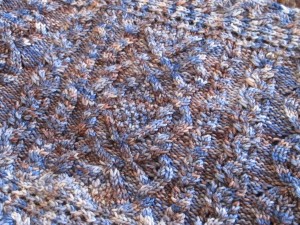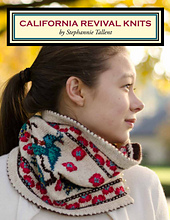Plans, not goals, not resolutions!
Book Deux: Last year the plan was to have it ready for Spring 2013 TNNA (at the time, there was talk of TNNA just having one big knitting orientated conference, combining Winter & Summer into Spring).
Now I’m shooting for Fall 2013 publication date. That means all the knitting should be done by Summer TNNA, and I’ll be able to put together a look book, but obviously the time line has been pushed back.
Regardless, I have more designs completed & some partially completed. Folks in my testers group have seen (and tested!) a few of the accessories.
I can say this book will be similar to CRK in many ways.
The skill level of the projects ranges from advanced beginner to intermediate plus. Projects include garments, hats, mitts, stoles, shawls, cowls & socks. Techniques include stranding (one of my favorites — and everyone who sees it –is a stranded hat done in Sunday Knits yarn), cables (lots of cables), textured stitch patterns, lace, beading, & nifty bicolored cables.
Also like CRK, the next book has a theme and related color palette. I can say, though, that architecture is not a consideration in this one. Flora, fauna, geology, and history are the subthemes.
Tempted? Teased? I hope so!
Hitch: As noted in the last post, Hitch grew. And grew. My goal is to have this in print prior to Summer 2013 TNNA, with the PDF coming out sooner. The last patterns are being tech edited (thank you KT!), some are awaiting tweaks by the designers, and then it all will go to layout.
Here’s a list of the designers:
Dani Berg, Jill Bigelow Suttell, Rebecca Blair, Brenda Castiel, Rachel Coopey, Jennette Cross, Anna Dalvi, Elizabeth Green Musselman, Kristen Hanley Cardozo, Glenna Harris, Becky Herrick, Elanor King, Nina Machlin Dayton, Triona Murphy, Carolyn Noyes, Luise O’Neill, Heather Ordover, Anne Podlesak, Stefanie Pollmeier, Nadya Stallings, Katherine Vaughan, Christina Wall, Christina Werge, Linda Wilgus, Karin Wilmoth, & of course yours truly (me)
And here’s a list of the yarns being used:
Anzula, Bijou Basin, Blue Sky Alpacas, Brooklyn Tweed, Cephalopod, Drachenwolle, Fyberspates, Harrisville, Hazel Knits, Hedgehog Fibers, Indigo Dragonfly, Knit Picks, Little Red Bicycle, Madeline Tosh, Old Maiden Aunt, Posh, Quince & Co, Shibui Knits, Sincere Sheep, Springtree Road, Socks that Rock (Blue Moon Fiber Arts), String Theory, Sunday Knits, Sweet Georgia, Tactile, Verdant Gryphon, Woolen Rabbit, Wooly Wonka, Zen Yarn Garden
I’m really excited about the collection! I’m hoping we can do some KAL & movie-a-thons. We’ll be starting a Hitch group on Ravelry specifically for KALs, etc.
Self published patterns
Right now nearly all my self published patterns are available on Ravelry. I have a few on Knit Picks not on Ravelry, and am planning an e book compilation of those to release on Ravelry & elsewhere.
I’d like to get all of those on Ravelry on Craftsy & Patternfish (sorry, no direct link for my patterns on Patternfish!). I’m also getting patterns uploaded to Deep South for wholesale (single patterns, not e books). As I’m updating formats, etc, and uploading to Deep South I’m updating the Ravelry (and Craftsy & Patternfish) listings.
I also have patterns from Sanguine Gryphon & Knitcircus that need to be reformatted & uploaded.
Okay, that’s old stuff, what about new?
I’m working on a couple cowl patterns to be used for class patterns. The goal is to design some super pretty patterns that are quite sneakily great for learning the techniques.
Otherwise, there will likely be a few more here & there, but my focus is the next book.
Teaching
I’ll be teaching at Madrona in February. I’m starting to set up more LYS & guild classes & talks, and would like to start teaching at other conferences.
If you’d like to see me teach a class at your local guild or LYS, let them know to contact me!
 I’ve always loved Kate & Courtney’s yarns and designs, so I’m excited to be a part of their blog tour celebrating their new collection, Kelbourne Woolens Volume 1.
I’ve always loved Kate & Courtney’s yarns and designs, so I’m excited to be a part of their blog tour celebrating their new collection, Kelbourne Woolens Volume 1.


















